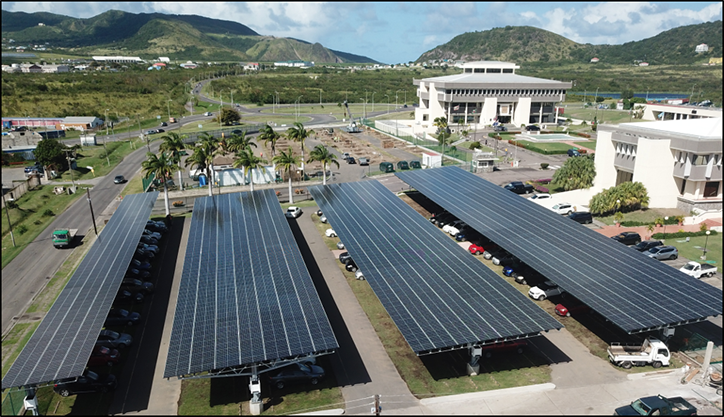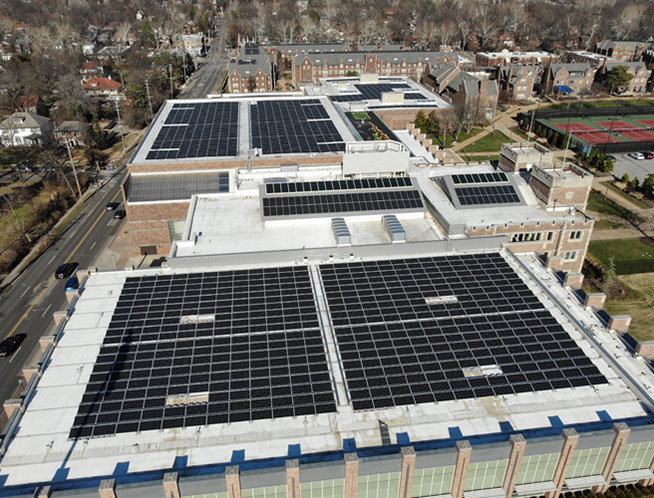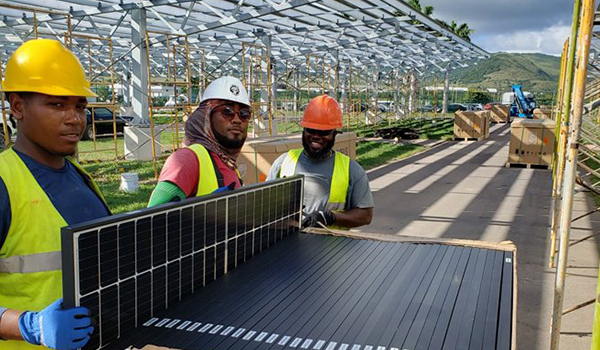Looking at last year in the rearview, we aren’t sure whether to call it the year of the PV Carport or the year of the PV+Battery Microgrid. There have been several of both types of specialized projects, along with our bread and butter of commercial/industrial rooftop PV and utility PV plants.
It was a very busy year. We completed 5 PV Carport projects. Two on MasterCard’s campuses in St Louis and New York, one for ITC Holdings in Detroit, one for the IBEW at their Local-1 headquarters, and one in Basseterre, St. Kitts, for the Eastern Caribbean Central Bank (ECCB). We have another carport in process for ECCB, about 50% larger than Phase 1. Most of these have included electric vehicle charging and some also include battery storage plants.
We also completed and started 4 microgrid projects. These range from Illinois to the Bahamas, all include PV, and some also include diesel gensets as a diesel-hybrid microgrid. One is powering a university data center. Drawing on our team’s experience with mission-critical facilities and infrastructure, we consider ourselves to be expert and integrating renewables and batteries into these complex facilities while improving reliability and survivability.
In 2019 we completed utility projects for Ameren Missouri and Central Iowa Power Cooperative. We also started a utility project for St Georges Cay Power Company in Spanish Wells in the Bahamas. This is another project for us defined by a 180 mph wind speed – requiring modules with extra strong frames (only a few manufacturers of those globally and none in the USA). We plan to report on completion in 2020 for at least 3 other coop and investor-owned utility PV projects.
As part of our commercial portfolio for the year, we completed 6 rooftop projects for Washington University in St Louis. This project totaled over 1.8 MW and will help WU achieve their goal of further decoupling growth from grid energy and carbon emissions.
This project also included a groundbreaking educational and engagement program with WU students, called “RESET.” The RESET program provided a wide base of introduction into the concepts of business planning, finance, policy, engineering, and construction related to the solar-energy industry. Since completion, we have teamed with WU to teach this program on an ongoing basis.
Find more about RESET on Azimuth’s website. You can also read WU’s 2019 SOURCE article on “Solar on the South 40? Students study bringing renewable energy home.”
Please let us know if you want to talk about any of these projects, a training program for university students, or how we can help you achieve your energy goals in 2020 and beyond.
All told, our Azimuth Energy and Solar Island Energy projects are reducing energy consumption onsite by over 400 GWh per year (yes, adding up all our projects in the last decade). That is around 1,400 GWh (1,400,000,000 kWh) per year in source energy that isn’t burned in coal or natural gas power plants. This is also equivalent to:
- Over 600 million passenger vehicle miles per year.
- Over 200,000 acres of forest.
- Over 1,600 railcars full of coal every year, stretching almost 17 miles.
Last year we were again ranked in the top-150 solar-energy companies in the USA for the 4th year running by Solar Power World Magazine. In 2019, we were ranked #77 EPC and #9 storage integration, and that doesn’t even include our projects in the Caribbean. There are many giant solar-industry companies much larger than us whose numbers are way higher – just think of all the coal trains that are being displaced by all our solar-energy colleagues across the country.
Our national energy mix will probably always include hydro, coal, natural gas, nuclear, and other sources. With the commitment of our solar-energy colleagues, local governments, and our clients, we are well on our way to making solar energy a significant and very economical part of that mix.
You can find out more about these projects on our Azimuth Energy website and our Solar Island website.
In 2019 we also contributed to Hurricane Dorian relief to help our friends and neighbors in the Bahamas. Together with our Bahamas office, we donated over 100 emergency solar-energy lighting and charging kits through the American Red Cross and Nassau Rotary. It will be a long road to recovery and we encourage as much support as you can muster. RMI, mentioned above, is fundraising for Bahamian hurricane recovery and they will be very careful with your donations.

In the photo above, we served as the Owner’s Engineer/Agent for the curved arrays wrapping around the parking garage at the MasterCard headquarters in New York. That was very complicated and challenging, and it was a pleasure to work with MasterCard and bring these projects online to help MasterCard achieve their environmental goals.

The picture above is the ECCB project in St. Kitts in the Eastern Caribbean. This is Phase-1 complete and generating energy. The Phase-2 site is visible in the background, where foundations are being constructed now. Yes, those are grass parking areas; what a terrific idea! Grass avoids the need for more stormwater management and is better for the ecosystem. The foundation is spread footers, and not drilled piers. That’s because we couldn’t locate a drill rig big enough to drill the piers without importing it from San Juan. This system is fully engineered to 180 mph wind speed, from the foundations to the modules and their through-bolting attachment to the structure. And about twice the corrosion-controlling galvanizing on the steel as we would use in the continental US to assure a 30-year service life. Again, there is a profile on our Solar Island Energy website.
We gravitate toward complicated, challenging projects that are outside the box for most of our competition, and we are good at executing them successfully. Whether it is a solar roof on a hotel restaurant or an isolated island microgrid – we love a good challenge.
Cost of Solar Energy
Unlike most things in life, the cost of solar electricity has been dropping now for a decade. It actually has been dropping for a few decades, but since we have been in business since 2007, the last 10 years is our most familiar point of reference.
The graph below shows how the cost of solar energy in the US market has changed compared to other forms of electric energy. Here is a translation of this graph regarding the levelized cost of electricity (LCOE) from these fuel sources. LCOE means the total cost of owning and operating the plant divided by the total energy produced.
- Solar has dropped from $200 per MWh (or $0.20 per kWh) to $40/MWh ($0.04/kWh).
- Natural gas has dropped from around $93/MWh ($0.09/kWh) to $56/MWh ($0.06/kWh).
- Coal has stayed pretty much the same at $109/MWh ($0.11/kWh).

In the Caribbean, that LCOE is around $0.09 to $0.12 per kWh. But that still is lower than the typical utility company avoided energy cost, and a lot lower than making electricity from diesel fuel, which is in the range of $0.38 to $0.45 per kWh. Read an article on the cost of energy from burning diesel fuel.
Meanwhile the cost of electricity from coal is roughly the same – despite the massive incentives received by that industry from the government for the last century. Electricity from natural gas has gone down about 30%, probably the result of massive supply and processing increases. And nuclear has gone up by 60% compared to ten years ago.
As far as we can tell, the supply of sunlight isn’t going to change for a very long time, so the cost of solar electricity should continue to drop. That is the result of economies in manufacturing and knowhow. But looking at the cost now and the way the curve has trended, we don’t expect to see nearly as dramatic reductions in the next 10 years as the last 10 years.
Regardless of these changes, there’s still no time like now to buy a solar-energy system. Waiting probably will not improve the financial business case. Our clients that bought solar-energy systems 10 years ago did pay more. But the financial performance of that buying decision was better than the option of waiting two years or longer. Read an article for more details on the cost of deferring an investment in solar energy.
The bottom line is that the solar panels would have to be completely free when you start the project in 2 years to make waiting a better decision than starting that solar-energy project today.
Not only is it a better financial investment today, but delaying that investment and its reduction in our carbon footprint also reduces the “present value of carbon reduction”, to borrow a financial term for the environmental side of the equation.

How About Climate Change & Why Are We in This Business? Solar Energy Is A Solution for Climate Change.
And all of this has been focusing on the financial performance only! How about the critical environmental benefits – which is one of the key drivers for Azimuth Energy and Solar Island Energy being in business in the first place, and the motivation for all of our talented staff to devote their careers here.
We sell renewable energy based on its financial performance, because that is the way many companies make buying decisions. We help our clients evaluate their solar-energy investment in terms of Internal Rate of Return, Net Present Value, Cap Rate, and Cash-on-Cash return – whatever financial language makes sense to them. If good environmental decisions also are good investment decisions, then its clearly a win-win.
We globally are faced with a challenge, regardless of the perspective of our transient federal administration. This is way beyond democrat, republican, independent, or anything else. While the earth will be just fine over time, this is about ensuring that the species now populating the earth remain here; including us.
While we aren’t talking about fisheries, this quote reflects a future with climate change. No offense to cockroaches.
Man wants to see nature and evolution as separate from human activities. There is the natural world, and there is man. But man also belongs to the natural world. If he is a ferocious predator, that too is part of evolution. If cod and haddock and other species cannot survive because man kills them, something more adaptable will take their place. Nature, the ultimate pragmatist, doggedly searches for something that works. But as the cockroach demonstrates, what works best in nature does not always appeal to us.
From COD, by Mark Kurlansky, 1997
As decision makers faced with an outcome that is highly risky but we can’t agree on the probability, the logical path forward requires managing that risk. That is basic business-management material.
Solar energy is just one part of the solution. Interested to know what you can do to help reduce climate change? There are so many things we all can do as individuals, corporations, families, or communities to effectively wage war against climate change. Because it is a war; arguably more important than any other military skirmish we may ever fight.

Solar energy solutions are two of the top-10 measures for combating climate change according to Project Drawdown. If you have never heard of this organization or seen their list of solutions to climate change, we encourage you to spend a few minutes looking at it today. Read more to find out how you can engage in this battle.
This also was highlighted on the CBS “60 Minutes” show on Sunday March 1st. The 60-Minutes team interviewed some of our industry colleagues from Rocky Mountain Institute following Hurricane Dorian in 2019.
Solar energy and microgrids can add to hurricane resiliency. But only if engineered and constructed with appropriate quality and attention to detail. As proven out in the 2017 and 2019 hurricane seasons, engineering and construction are not commodities. Poor quality and cutting corners in hurricane territory is like cheating on your taxes. All is well … until the next Cat-5 hurricane.
Survivability, resiliency, and affordable quality are where our expertise shines brightly. We invite you to call us to talk about your island microgrid project and how to reduce risk, reduce energy OpEx, and perform better in all ways.
Learn more here:
- 60 Minutes, Storm-Ravaged Bahamas Rebuilding Its Power Grid with Emphasis on Solar Energy
- Our co-authored publications on Caribbean hurricane resiliency and survivability: Solar UnderStorm I and Solar Under Storm Part II

